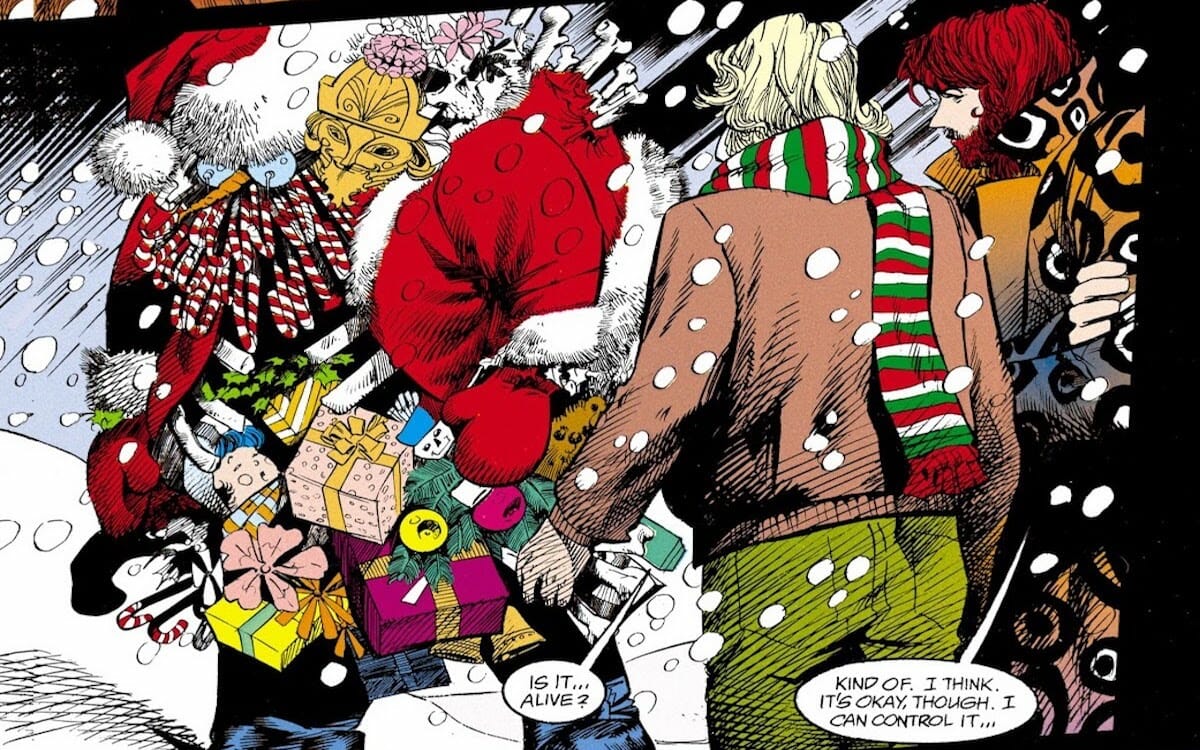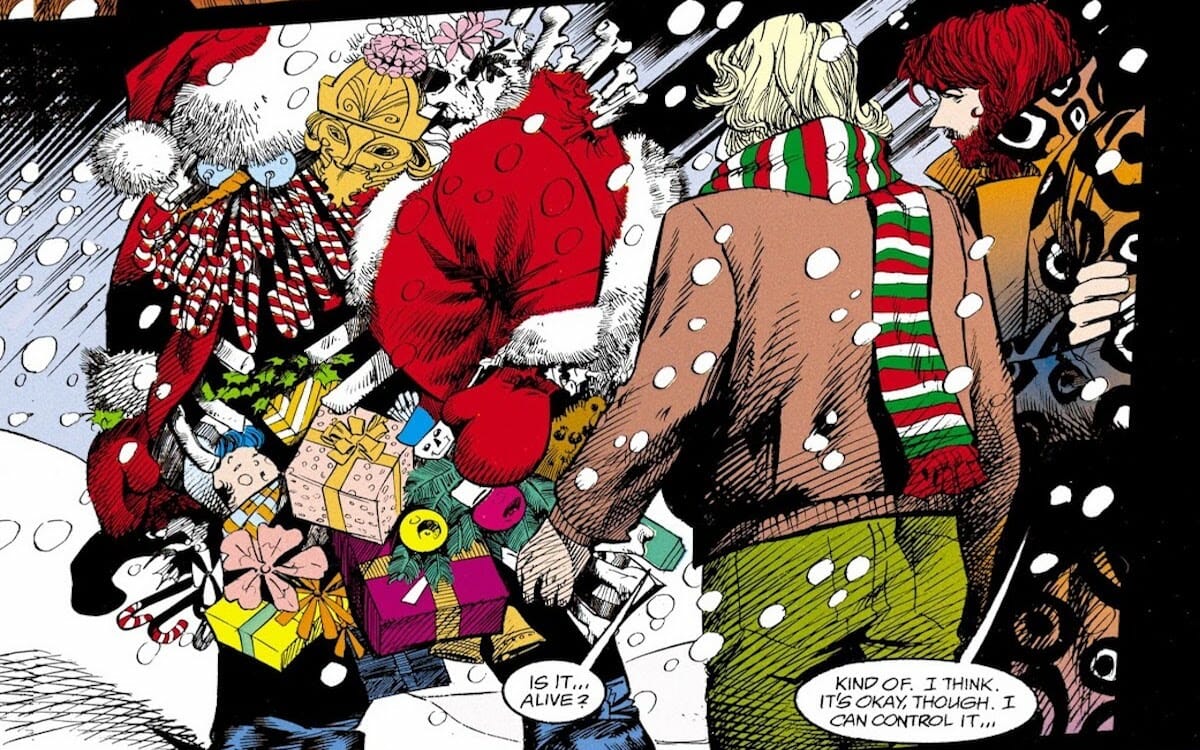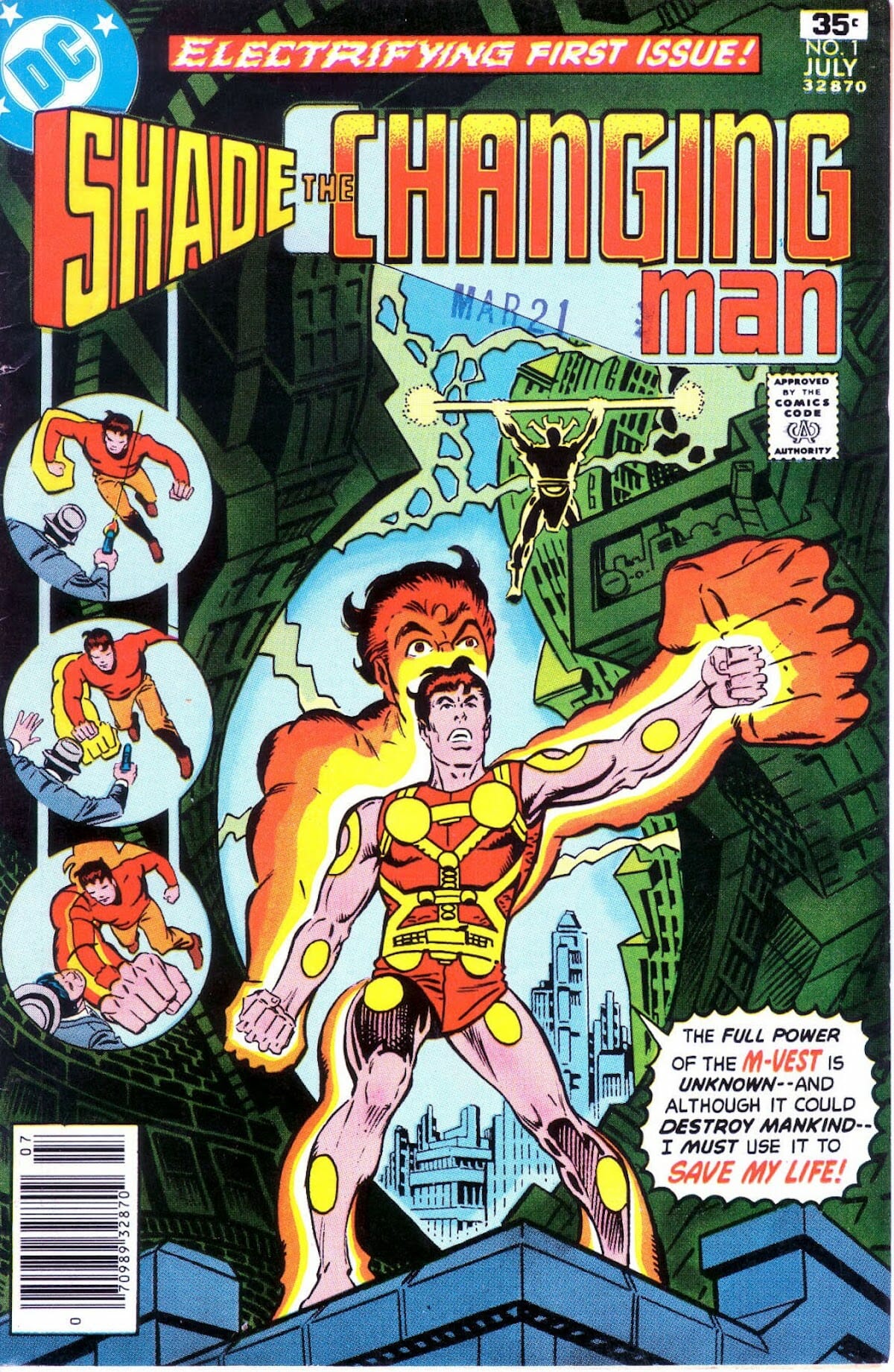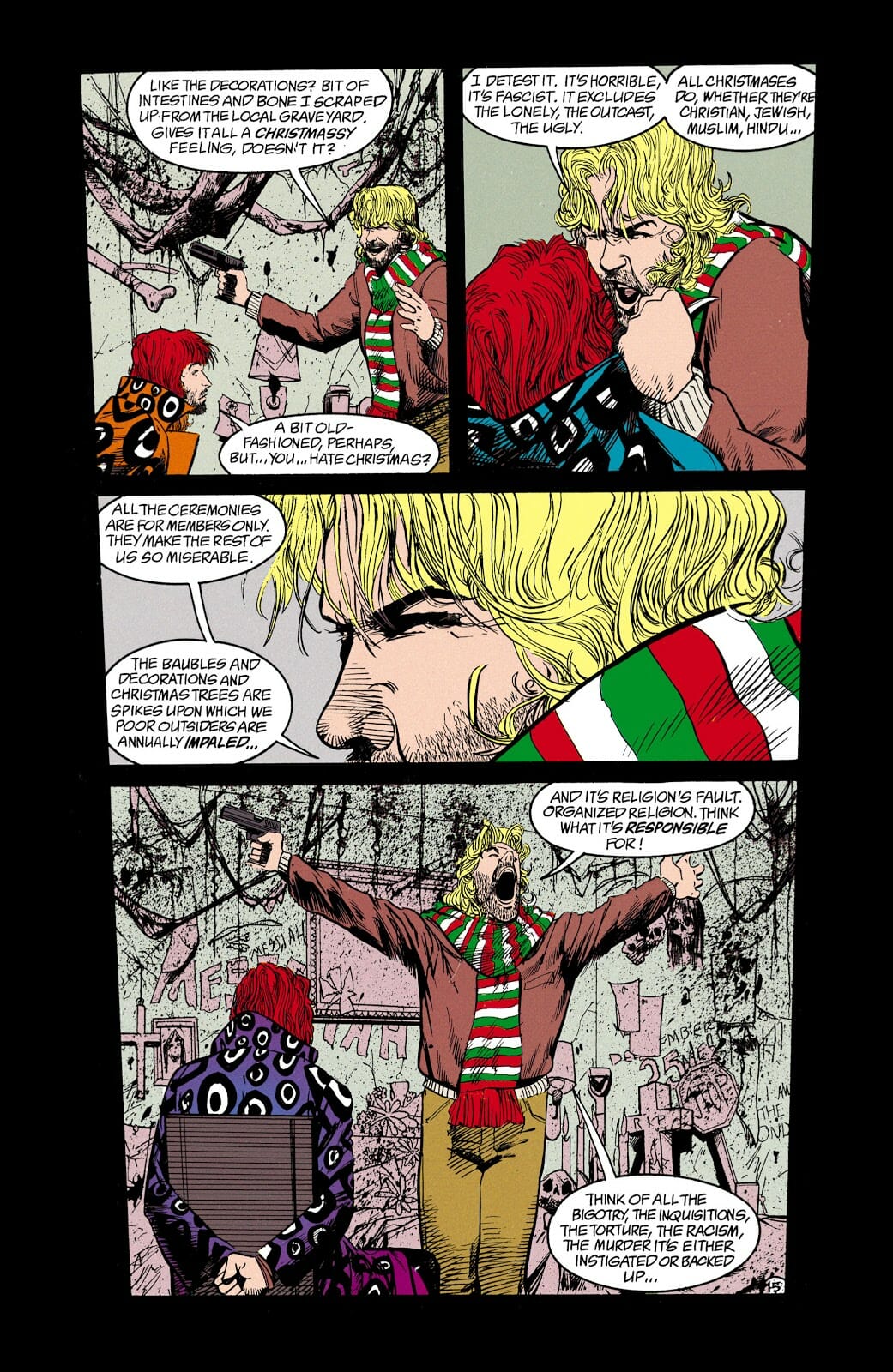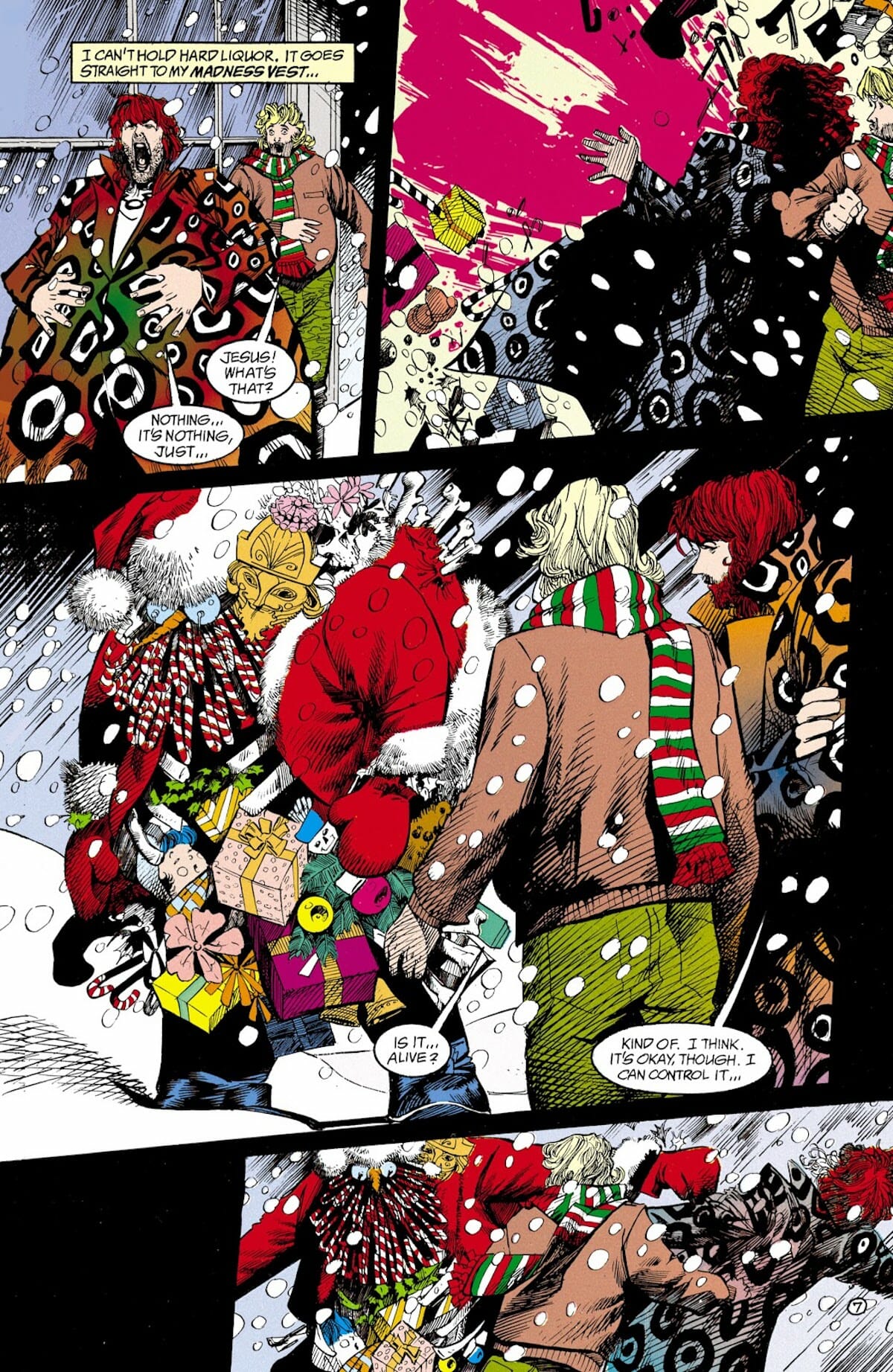Listen – Rac Shade was lost in time; and in America; and in his own mind; and in pretty much everywhere else. Granted, this is not as succinct as Kurt Vonnegut but no less true. Shade the Changing Man, by Peter Milligan and Chris Bachalo (and a host of other fine artists), was a strange masterpiece. It’s one of these hidden gems of early 1990’s DC comics, when all the ingredients for Vertigo were already in place but nobody called it that yet, despite running almost as long as Sandman (72 damn issues) and being much loved at the time.
Somehow, Shade the Changing Man remains stubbornly hidden; partly because it never got a decent reprint treatment (the farthest they ever gotten was three trades, ending at issue #19). You can read it digitally, but thanks to Bachalo’s wild stylistic swings and full use of the page, often eschewing traditional panel breakdowns, this is definitely a series that works best when you can see the whole page at one go. The other reason the series isn’t as popular as the likes of Animal Man or Swamp Thing is because it’s Milligan. Like the other big M’s of the British Invasion (Moore and Morrison), Milligan made his bones in British science fiction anthology 2000AD with a bunch of strips that were both eclectic and literary; an approach he later brought to his American work. Unlike Morrison and Moore, his work tended to have a slightly more wry flavor to it, which made it a bit harder to connect with.
Milligan’s work was ‘cool’ in the old sense of the term, totally assured of itself with no need or desire to please anyone else. Moore and Morrison burnt like supernovas, their work often feeling like shouts of defiance, while Milligan burned like a cold, controlled flame. The stories often seemed to keep emotional distance from the characters (which is not to say the characters lacked emotion, just that the plot always kept its gaze above them), and the scripts would often comment upon themselves. If you ever thought about trying to analyze the work you’d soon see it has beaten you to the punch.
While you can see all of his works (Human Target, The Extremist, Bad Company), this approach is most noticeable in Shade the Changing Man. The series acting as a revival of a short lived Steve Ditko creation of the same name, chosen partly because Milligan enjoyed the unique visuals and naming conventions Ditko brought to the original and partly because it was an obscure enough character for him to re-work without worrying about audience reaction. That regular Shade was just coming off a series of appearance in Suicide Squad seemed to have escaped his notice. The plot, such as it is, involved Rac Shade, a humanoid from the dimension of Meta, manifesting on Earth in the body of a serial killer.
Shade has some problems though: The manifestation was a traumatic event that left him unsure of his mission or abilities. The serial killer in question was just going to be executed and so the authorities are after him. the woman who accompanies him (Kathy George) happens to have lost her parents and fiancé to said serial killer. The people who sent him to the Earth in the first place aren’t as benevolent as they appear to be. Also, he’s in America – a land seemingly on the brink of a mental breakdown. On the run, Kathy and Shade travel across the American landscape and the American culture: “I’m part of all of you now. We’re all going on a long ride together. A ride across the mental states of America… I’m your liberated dreams baby. Your liberated dreams and your unfettered screams…” As they move from one random spot to another the series covers topics such as the obsession with film stars, the assassination of JFK and (of course) Christmas.
The issue in question, and the reason for this (critical) season, is #19 – “Bethlehem, U.S.A.” It follows Shade on Christmas Eve as he ruminates on a holiday in Meta which, coincidentally, turns out to be much like Christmas: “There’s an annual celebration on Meta to remember the day he dug up the bones of the dead and brought them back to life… This was our Christmas. The Day of Bones. In older days folk would dig up the actual bones of relatives and hang them in their parlors […] Nowadays the skeletons are plastic, usually filled with a special liquid that glows bright colors.” The issue evokes the classic complaint made about ‘modern’ Christmas (for whatever your value of modern is), that it has become corporate and commercialized; lost its sublime religious meaning.
As Leigh Eric Schmidt notes in his 1997 book Consumer Rites, this type of argument is overused and overfamiliar: “This concern plays on an essential nostalgia in modern industrialized societies for the genuine, the handcrafted, the authentic or the real. Modern holidays and their rituals are often thought to be insubstantial, ersatz or hollow[.]” Similar in tone to the forever-recurring question of why kids these days are so disrespectful to their elders.The notion of the Golden Age is always wielded as a cudgel by the adults, to strike at the young. Always slightly ahead of the reader, Shade #19, brings this argument up only to knock it aside.
Here, the notion of authenticity becomes tied to a rather ghoulish act of digging up the bones of the dead, itself a literalization of the toxic nostalgia Schmidt identified. Digging up the bones, letting the past physically hang above the present. It’s a way to ensure no one is ever satisfied, on a spiritual level, because no one can measure up to the perceived ‘golden age.’ Despite being founded on principles that are meant to be self-correcting, the American constitution comes ready-made with the notion of ‘amendments’ as a way to correct the mistakes of the past, the United States suffers from the same nostalgic sickness. Which is why no one can be truly satisfied, even in this holiday that is seemingly manufactured to spread joy.
This notion of a “golden age” goes against everything Shade represents – he is the changing man after all. The notion of eternal stability, which can only arrive if you believe perfectness has been achieved, is anathema to him. Soon, Shade meets a strange fellow named Dave, who claims to be looking for the new Messiah. After witnessing Shade drunkenly demonstrating his powers Dave becomes convinced Shade is the one he’s looking for… at which he swiftly knocks the Changing Man out, revealing he’s been looking for the new messiah so he could kill them. Shade’s power demonstration is one of the few times in this story Bachalo is allowed to let loose, his image of a warped Father Christmas (John Carpenter’s The Thing if he was made out of gifts and candy) is a particular highlight.
The issue is rather subdued in Bachalo’s terms; while he’s not the only artist on the series his style defines it. Athletic and highly adaptive, Bachalo’s seems to do the impossible over and over again, conjuring up strange new visuals without surrendering to cliché. The world of Shade feels genuinely unstable thanks to his pencils, forever tittering on the brink of chaos. Every other issue so far seems to present a new challenge from the script, some impossible request which Bachalo somehow manages to work into a coherent narrative. One would expect a quiet issue to feel like a bummer and a waste; but instead of being a letdown it works in the context of the story. The repeated shots of a befuddled priest show his ability to translate human emotions without reaching big crazy gestures. He really could do it all.
Back into the plot: Why did Dave kidnap Shade? Because he hates Christmas – “I detest it. It’s horrible. It’s fascist. It excludes the lonely, the outcast, the ugly.” Dave plans to off Shade and then go out on a killing spree, forever tainting the holiday in that nation’s mind. Dave isn’t just out to harm people, he’s out to harm the very psyche of the nation. A grand ambition for a madman with a gun, but in America a madman with a gun can often change the entire country (just ask the JFK storyline in issues #2-3).
Even in the midst of this Christmas issue, with Shade hurriedly letting us know we probably shouldn’t worry too much (“You know by reading this letter that he didn’t kill me”), the series interest remains laser focused on America. Or rather, America as experienced from the outside. Some of Dave’s complaints are justified. Religion can be violent, Christmas can often be a members-only club (so my Jewish-American relatives let me know), the celebration of wealth can feel like a mocking of the poor and yet… Dave’s issue here is not really any of these things – he’s lonely, he feels out of touch with everything around him. But what he’s looking for he cannot find, no more than conservative social commenters can bring back the golden age. All that is left to do is to rage and rent and do violence and those who have ‘failed’ us.
Unlike other Christmas antagonists, unlike Scrooge or the Reindeer who bully Rudolph, there is no quick cure. The Christmas doesn’t end with large bloodshed, though it seems Dave did manage to kill some people in the church before Shade got to him (and Dave himself, flattened by a Christmas tree, might not have made it), but it doesn’t end with Salvation. There’s no triumph to be had, the spirit of Christmas does not magically save everyone, and Shade doesn’t learn the true meaning of the holiday.
Instead, he sits alone in his room, finishing his letter. Shades ends up pondering an old Kafka piece – “The Messiah will only come when he is no longer needed,” changing it in his mind to “The Messiah will only come when he is no longer recognized.” Is Shade the messiah then? A lonely being on a journey that ends up helping people and releasing them from their various neurosis, while taking more and more unto himself, an act of unintended self-sacrifice. Or maybe Dave is the messiah? the new American Messiah – bringing ‘peace’ with a gun (the American way). Or maybe the Messiah is just one of the side characters (such as the pries)? Or maybe we don’t see them at all. They’re out there, in this great and sick land, unknown and unloved.
Christmas stories are often about easy answers, the last minute save by the divine agent, the miracle, the salvation. Shade has no easy answers to offer us; not the series and not its protagonist – a confused drunk who hasn’t figured himself out (much less the world). In that he is still the perfect protagonist for this day and age, no matter how lost you feel, even the happiest time of the year, there is always tomorrow and the promise of change. Leave the bones of the past in their graves.
